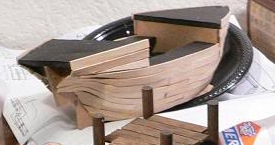Thanks much! I dredged up a few pics but the stuff needs a thorough dusting before I take any new ones.
To answer/expand on stuff:
I don't have the graphics for the posters anymore (I saved them for quite a while, but this stuff is all from 6-7 years ago, and dead computers are a bother). However, you can find a ton of good stuff just by googling images for Victorian Posters or Heraldry. Most of it was random, but I chose one or two things specifically (I put the 95 theses into a tiny font to post on the door of the church). I shrunk it all down, printed it onto normal (cheap) white paper, and soaked it in weak tea for coloring. Simple and easy, and it was definitely one of the things I think turned out wonderfully; a couple sheets of paper and maybe 15 minutes of work (total) yielded enough posters for an entire city.
The cemetery turned out well, except for the cliffs (it was my first attempt at that, and I'm still pretty clueless about how to make it look nice).


It was inspired by Pere Lachaise Cemetery, which is similarly raised and accessed by stairs; the tomb was inspired (very loosely) by that of Abelard and Heloise, and was due to have a roof at some point. The tops of the markers are done with colored paper and very small print; the fence is skewers, toothpicks and stir sticks.
The canals/docks were the last additions to the board, and introduced more levels; they required all my previous stuff be set on 2" foam supports atop the table. Not much to them, really; I made a couple molds to mass produce boxes, barrels and bags (some of my own design, some copied) and I sanded a few down to give them the appearance of bobbing in the water as debris. The shine on the completed section was from a thin coat of water effects; the docks are just craft sticks and dowels glued together in a couple stages.

The boat was a complete terror. It was laid down with a foam board deck and hardboard keel and a half dozen ribs. I then applied an outer hull made of stir sticks (Starbucks has the best ones). They had to be soaked in water, then bent carefully, trimmed with an exacto, and glued with wood glue. I used a set of small clamps to keep them in place; the process and lack of clamps (and room to apply more clamps) meant I could only apply 2-3 boards per night. The railing was done with "fancy" toothpicks, and didn't last; when I complete it, I'll drill out holes to put the uprights into for strength. I also have a few extra bits to add, like a wheel and anchor. Overall, it was a great success: it's a great impression of a boat, with a good amount of usable space, without taking up too much of the board. I would never do it again that way, though, simply because the time involved. Instead, I think I would try to thicker wooden blocks as a frame and use tacks/small nails to fasten the planks in place.
All the grey is...meh. Keep in mind, this was a work in progress; my intention was to 1) make enough buildings, roads, squares, etc to completely cover a board with a few options to swap out, 2) add details and some color (roofs! furniture, rubble, doors, shutters, and so on) and 3) make a plethora of movable obstacles for the streets. I got about 80% through #1. However, my intention from the first was to have a somewhat drab, colorless ruin, in which our figures would stand out during play. Despite all the work, after all, terrain is just a background.
In person, it's usually the cathedral that people notice, and that's what my friends always bring up when my scenery is mentioned. It's 18"x24", so a pretty large piece.

The doors are functional on a much simpler design than the plastic-tubing one I usually see: I simply glued a bit of dowel to the end of each door and drilled a hole for it to fit into in the craft sticks forming the frame (the 95 theses are on the right most door, and aren't in any of my shots, alas). The windows are color printed transparencies, of the sort we old people saw on overhead projectors all the time in our youth.
Also a couple more buildings:
The constabulary, with various public instruments of death (the gallows does not, alas, function):

And the factory, which is far short of complete (I had some great flying machine models once, and printed out a ton of schematics to drape on work tables and walls):

As far as issues, the main one I keep facing is the decision to base everything on a grid. It's very defining, made creating angles a bit of a chore, and provided an artificial prop to estimate distance. If (when?) I start on a new round of building, I plan to make a base or mat, probably with textured wall paper, and design buildings to just sit atop. That introduces other issues, of course (still sorting out how to make a sewer work with that idea, and how to make vegetation and bases blend in).



